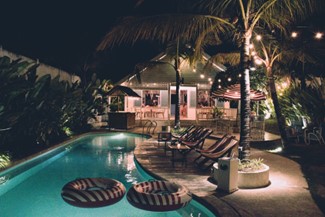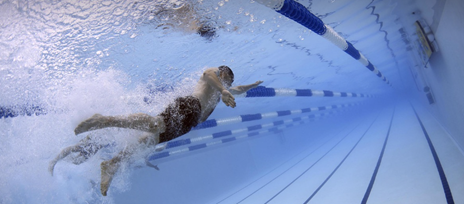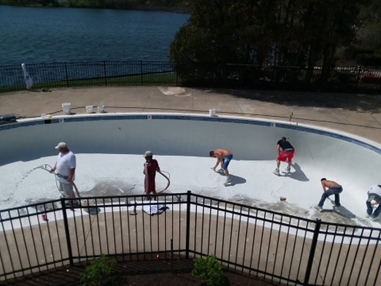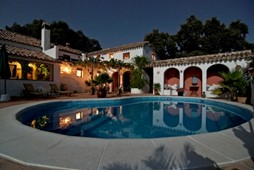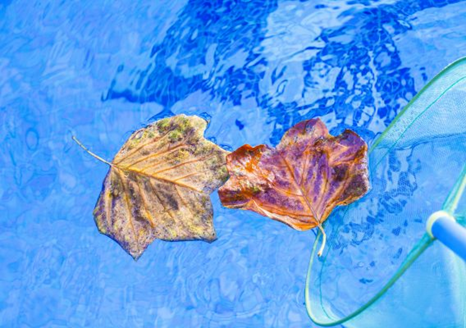With the winter’s thaw comes the anticipation of sunny days lounging by the pool. But before you can dive into those refreshing waters, your inground pool needs a wake-up call from its winter slumber. Preparing your pool for spring is crucial to ensure a season filled with joyful swims and relaxing afternoons poolside, particularly if your pool has a delicate plaster finish that requires specific care. Here’s an essential guide to revitalizing your pool.
1. Remove the Pool Cover, Clean, and Store It
Before anything else, remove debris, water, and snow from your pool cover. This can be done using a pump or a leaf net. Ensure that you remove the cover carefully to avoid spilling any accumulated debris into the pool water. Once the cover is off, clean it thoroughly to remove any dirt and algae. Allow it to completely dry to prevent mildew before folding and storing it in a cool, dry place.
2. Debris Disposal and Surface Skimming
With the cover stored away, use a net to skim off any debris on the water’s surface. Follow up with vacuuming the bottom of the pool to suck up all settled particles and brush the sides diligently, especially if your pool has a plaster finish which is prone to algae build-up.
3. Inspect the Pool Area
Check the pool deck and surrounding area for any signs of damage or wear. Repair any cracks or uneven areas in the decking to maintain the safety and aesthetics of your pool environment. Examine the plaster for any signs of deterioration, such as cracks, etching, or discoloration. Spring is the perfect time for repairing plaster to guarantee a smooth and aesthetically pleasing surface that enhances your pool’s appeal.
4. Check Pool Equipment
Examine all your pool equipment, including the pump, heater, filters, and hoses, for any signs of damage. Replace or repair parts as necessary. Ensure everything is clean and in good working order before using the pool regularly.
5. Water Levels and Leaks
If you drained your pool for the winter, now is the time to refill it. If your pool was partially drained, refill it to the appropriate level. Keep an eye out for any signs of leaks, which can be more apparent during refilling.
6. Balance the Water Chemistry
Once your pool is filled, test the water for pH, alkalinity, and sanitizer levels. Adjust the chemicals gradually to reach the desired balance. This is critical to prevent corrosion or scaling on your plaster finish and to ensure the water is safe for swimming.
7. System Shock
After a long winter, you should shock your pool to eliminate bacteria, algae, and other organic contaminants. This restores the clarity, sanitizes the pool, and promotes water safety.
8. Filter Functionality
Run the filtration system continuously for at least 24-48 hours to circulate the new chemicals and distribute them evenly throughout the pool and filter out any remaining impurities. Check the filter pressure and backwash if necessary. Monitor and adjust the filtration settings as needed to maintain water clarity and cleanliness.
9. Set Up Pool Accessories
Reinstall any ladders, diving boards, and other accessories stored over the winter. Check and oil any moving parts (bolts, hinges, etc.) to ensure they are safe and functional.
10. Schedule a Professional Inspection
Consider having a professional pool service company, such as Pound Pool Plastering, Inc., perform a thorough inspection early in the season. We can spot issues you might miss, particularly with your filtration system and plaster surfaces.
11. Prepare Safety Equipment
Ensure all safety equipment, including life rings and pool alarms, are in place and in good working condition. This includes checking pool barriers, safety covers, alarms, and rescue equipment, which are crucial for preventing accidents.
12. Maintenance Ready
Restock your pool maintenance supplies, including test strips, chemicals, and cleaning equipment. Having everything on hand will make regular maintenance throughout the season much easier.
Taking the time to prepare your inground pool for spring properly will enhance your swimming experience and help maintain the integrity of your pool’s plaster finish and equipment. Start early to ensure that your pool is ready to go as soon as the warm weather hits so you can enjoy an entire season of fun and relaxation in your beautifully maintained pool.
Need Plaster Repair? Contact Pound Pool Plastering, Inc. for an Inspection and Quote.
Pound Pool Plastering services residential and commercial pools in applying a wide variety of pool plaster finishes and complete renovations. We offer Diamond Brite, Sunstone, Hydrazzo, and Marcite – and a great selection of tile choices and coping stones. Owner Dale Pound personally oversees each pool project to ensure the highest quality is delivered. Call or email us for a free estimate.
Written by the digital marketing team at Creative Programs & Systems: https://www.cpsmi.com/


